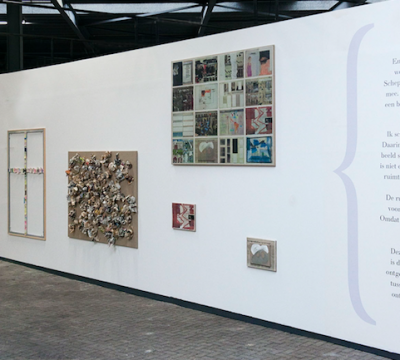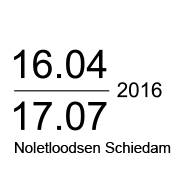harry haarsma
Harry Haarsma (Brunssum, 1955) combines his painting with the creation of artists’ books. He paints with a discerning sense of the importance of what lies beyond the edge of the frame. In decided lines and cool compartments of colour, he manages to capture this unmistakable ambiguity. Alongside his paintings, he creates books in which he reflects on the everyday world in front of us. Word, image and painterly intervention delicately enter into a relationship.
Harry Haarsma studied at the Hogeschool voor de Kunsten in Kampen and at the Hochschule der KüŸnste in Berlin. Previous exhibits of his work include Schiedam, Rotterdam, Nijmegen and Heerenveen.
The exhalation of the world
Had you asked Marcel Proust where, according to him, the beginning lay, he would have answered: ‘With that biscuit, that madeleine, naturellement’. The scent of the biscuit opened a world full of images, associations, memories, sounds — a world of days gone by, which suddenly sprung to life in language. Ask artist Harry Haarsma (1955) where the beginning lies, and he will try very hard to give you an answer, but he won’t find it. And yet his work, spanning eight monumental episodes in front of you at the Noletloodsen, bears the title of Archè, — ancient Greek for ‘beginning’. The ancient Greeks debated the essence of this beginning, the principle of primordial matter, heavily. It was water, said Thales of Milete. Fire, said another. Earth said yet another.
To Haarsma, Archè refers to a great many things: it refers to the reservoir of images, sensations and memories, stored in the form of primordial matter in his brain and in his studio. But it also refers to the image as a desire, explored and organised by artist Haarsma. He has a rather ambivalent relationship with that image. Not because he distrusts the image in itself, but because of all that hangs around it, dances, blares, flirts, and clouds our vision. It’s not for nothing that he has a quote from the exquisite Belgian author Marguerite Yourcenar hanging over his bed: ‘Our imagination tries desperately to dress things up, but things are divinely naked.’ That ‘divine nudity’ is what Haarsma explores.
How does such an investigation work, and what is the result? To start with the latter: Haarsma’s work consists of a dazzling combination of drawings, edited photographs, postcards, post-its, newspaper clippings, poems, quotes from far and wide, newspaper headings, paintings. He creates extraordinary artists’ books, sticks newspaper spreads onto linen, paints over them, cuts pictures out, or focusses purely on quotes. ‘Depth is an optical illusion’, is paraded along the top of an imageless spread where the depth seems to have been removed. ‘End to western certainties’, another heading postulates. In another work, he contrastingly blows the photographs up and grids them, granting them a mysterious abstract quality. A beautiful example of this is the image resembling a flimsy cloud over the sea, which are in fact soapsuds being used to clean a window. He builds ‘houses’ filled to the brim with images, the size of a postcard. Those postcards may come from Haarsma’s own archive, but may equally be painted: often abstract dots, lines and smudges, something that looks like air, water and indeed: breath. Vermeer’s letter reading woman is distracted by blue stripes of paint, making the text surrounding her (printed upside down) illegible. The averted gaze of Gerhard Richter’s Betty (1988) is accompanied by a hideous newspaper photograph of prisoners held under barbaric circumstances.
The concerns Haarsma unwittingly shares with you not only extend to the image, so omnipresently surrounding you that you can barely still comprehend its value or meaning. In a time like ours, ruled by consumptive and emotional kitsch and by financial powers that undermine everything remotely related to humanism or care for that magnificent blue planet, it becomes ever more difficult to discern and truly fathom. Belgian philosopher Lieven de Cauter describes this beautifully in his latest book Metamodernity for beginners. The comprehension of the zeitgeist, says De Cauter, is a practically impossible task: ‘Presence of mind is a must more than ever, but being able to deal with the present, truly being part of it, is increasingly difficult due to the explosion of knowledge, the complexity and interdependence of globalisation, the acceleration of the rhythm of life, the fragmentation of history and the dualisation of the world. Holism is a must, but who can oversee it all and synthesise it? Even a giant like Hegel would come up short today.’
Haarsma attempts to devise that synthesis by searching for the beginning, the ‘true image’ that speaks of good and evil, clear and unclear, empty and full. To show that, in its full nudity, one requires a frame that reflects multitude. And the realisation that the end, the true beginning, will always lie just beyond reach.


